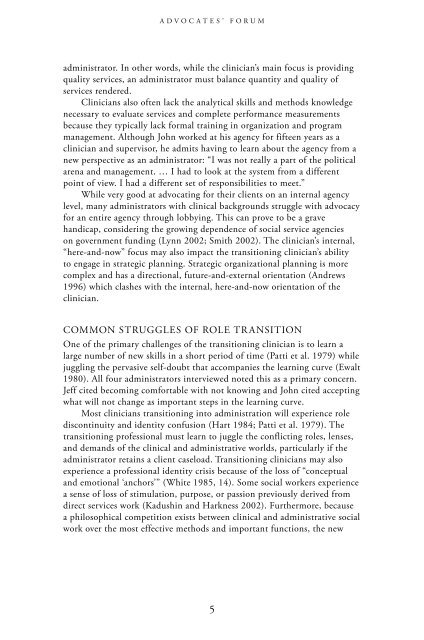DEFINING PROBLEMS. SHAPING SOLUTIONS . - School of Social Service ...
DEFINING PROBLEMS. SHAPING SOLUTIONS . - School of Social Service ...
DEFINING PROBLEMS. SHAPING SOLUTIONS . - School of Social Service ...
Create successful ePaper yourself
Turn your PDF publications into a flip-book with our unique Google optimized e-Paper software.
a d v o c a t e s ’ f o r u m<br />
administrator. In other words, while the clinician’s main focus is providing<br />
quality services, an administrator must balance quantity and quality <strong>of</strong><br />
services rendered.<br />
Clinicians also <strong>of</strong>ten lack the analytical skills and methods knowledge<br />
necessary to evaluate services and complete performance measurements<br />
because they typically lack formal training in organization and program<br />
management. Although John worked at his agency for fifteen years as a<br />
clinician and supervisor, he admits having to learn about the agency from a<br />
new perspective as an administrator: “I was not really a part <strong>of</strong> the political<br />
arena and management. … I had to look at the system from a different<br />
point <strong>of</strong> view. I had a different set <strong>of</strong> responsibilities to meet.”<br />
While very good at advocating for their clients on an internal agency<br />
level, many administrators with clinical backgrounds struggle with advocacy<br />
for an entire agency through lobbying. This can prove to be a grave<br />
handicap, considering the growing dependence <strong>of</strong> social service agencies<br />
on government funding (Lynn 2002; Smith 2002). The clinician’s internal,<br />
“here-and-now” focus may also impact the transitioning clinician’s ability<br />
to engage in strategic planning. Strategic organizational planning is more<br />
complex and has a directional, future-and-external orientation (Andrews<br />
1996) which clashes with the internal, here-and-now orientation <strong>of</strong> the<br />
clinician.<br />
Common Struggles <strong>of</strong> Role Tr ansition<br />
One <strong>of</strong> the primary challenges <strong>of</strong> the transitioning clinician is to learn a<br />
large number <strong>of</strong> new skills in a short period <strong>of</strong> time (Patti et al. 1979) while<br />
juggling the pervasive self-doubt that accompanies the learning curve (Ewalt<br />
1980). All four administrators interviewed noted this as a primary concern.<br />
Jeff cited becoming comfortable with not knowing and John cited accepting<br />
what will not change as important steps in the learning curve.<br />
Most clinicians transitioning into administration will experience role<br />
discontinuity and identity confusion (Hart 1984; Patti et al. 1979). The<br />
transitioning pr<strong>of</strong>essional must learn to juggle the conflicting roles, lenses,<br />
and demands <strong>of</strong> the clinical and administrative worlds, particularly if the<br />
administrator retains a client caseload. Transitioning clinicians may also<br />
experience a pr<strong>of</strong>essional identity crisis because <strong>of</strong> the loss <strong>of</strong> “conceptual<br />
and emotional ‘anchors’” (White 1985, 14). Some social workers experience<br />
a sense <strong>of</strong> loss <strong>of</strong> stimulation, purpose, or passion previously derived from<br />
direct services work (Kadushin and Harkness 2002). Furthermore, because<br />
a philosophical competition exists between clinical and administrative social<br />
work over the most effective methods and important functions, the new<br />
5
















